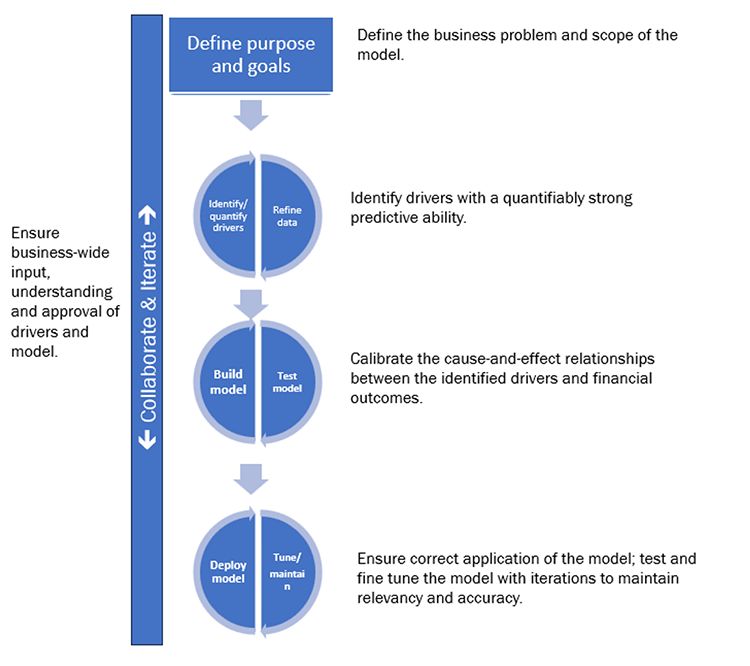Articles
The FP&A Role in Driver-Based Modeling
- By AFP Staff
- Published: 3/5/2024
 An FP&A team turned to driver-based modeling to align finance, strategy, culture and operations.
An FP&A team turned to driver-based modeling to align finance, strategy, culture and operations.
When the owners of certain drivers understood the impact of certain events or occurrences on the company, they would be in a better position to create positive change — to accurately steer their financial strategies.
The AFP FP&A Case Study series is designed to help you build up key FP&A capabilities and skills by sharing examples of how leading practitioners have tackled challenges in their work and the lessons learned.
Presented at an AFP FP&A Advisory Council Meeting, this case study contains elements that are anonymized to maintain privacy and encourage open discussion.
Get more on this topic:
Download the AFP FP&A Guide to Driver-based Models and Plans to see a comprehensive framework on driver-based models including how these can benefit your team.
Insight: Driver-based modeling is comparable to the steering wheel of your organization — it empowers teams to steer their financial strategies with accuracy and simplify decisions by focusing on the most important areas.
| Company Size: | Medium |
| Industry: | Aviation |
| Geography: | Middle East and Africa |
| FP&A Maturity Model: | Finance & Business Acumen |
Finance and business acumen: FP&A translates corporate and business strategy into a financial plan and supports the enactment of that plan through resource allocation. Processes generate input and insight through financial analysis, supported by enabling technology.
Background: General Information About the Company
The subject of this case study is an airport management company. It is quasi-government, i.e., a private company that is supported by the government with a public mandate to provide a given service — in this case, the management and operation of a major airport.
The company is dedicated to fulfilling its mission of serving passengers and enabling the smooth movement of aircraft to address the escalating need for global connectivity. It employs more than 1000 staff members and has a target revenue of $4 billion.
The presenter is the Head of Finance Transformation, responsible for finding opportunities for financial growth, supporting informed decision-making and driving success.
Challenge: The Work or Difficulty FP&A Had to Address
The company faced four inter-related challenges that were captured in the model:
- Financial: Figuring out how to reduce the gap between the budget, business plan and current levels of operations.
- Cultural: Transforming the company’s culture to create accountability among business leaders down to the staff level; these types of cultural transformations take an average of two to three years.
- Strategic: Adhering to the mandates and many regulations that come with being a quasi-government-owned company.
- Operational: Completing of a major terminal expansion project.
Approach: How FP&A Addressed the Challenge
The FP&A team developed a driver-based model as a tool that could help meet the challenges outlined above. Their approach follows the generalized AFP approach for driver-based models (illustrated in the graphic below).
Step 1: Define Purpose and Goals
The FP&A team needed to ensure their goals were built into the financial plan and that there would be operational discipline around their financial plan. Otherwise, they reasoned, there was no purpose to having a financial plan.
“We would just be playing with the numbers. Does it matter if we hit them without knowing the long-term goal or the short-term budgeting goal?” said the Head of Finance Transformation.
Step 2: Identity the Key Drivers and Refine the Data
“Our key business drivers begin with what drives revenue; the expenses fall in line after that,” said the Head of Finance. For an airport authority, this is 1) the number of aircraft that use the facility, which drives airline fees, and 2) the number of passengers, which drives occupancy of commercial rental spaces and retail revenue from those spaces, such as retail and food concessions. Therefore, the company has developed key metrics around international economic conditions that influence the number of flights and international passengers.
Due to the seasonality of the aviation industry, the FP&A team does not use linear regressions. Instead, they use other quantitative methods, such as a three- or six-month moving average reflected on year-over-year historical data. They check the coefficient of determination (R²) to determine the strength of the relationship. This is currently done on a spreadsheet; however, the team is looking into the use of some of the newer technology tools to help them forecast for the operations team.
The amount of information collected is tremendous, and FP&A partners with the statistical team in the operations department to refine and mine the data. When the aircraft lands, they know how many passengers were on that airplane, when it touched the ground, how many hours it was parked and when it left; all of these factors affect the revenue and correlated expenses. Five or six systems are integrated into one, including the ERP, to help the statistical team process the data, which includes such things as aircraft movement and passenger type.
Step 3: Build and Test the Model
The FP&A team applied historical data and ratio analysis to the key drivers to derive the remaining elements of the forecast. While there are always wild cards, there are some metrics the company can rely on, including OpEx per passenger and inflation.
Next, they conducted scenario analysis and sensitivity testing: base case, best case and worst case. “We have to take those into consideration because even if we build the budget, we need to see potential variations and how the model and business would react under extreme conditions,” said the Head of Finance Transformation. They also test for budget slacking, i.e., overestimating expenses and underestimating revenue in order to avoid significant differences with the actuals.
Airports Council International provides the company with operational benchmarks from two thousand participating airports worldwide. Using these benchmarks, the company can compare their forecasted and actual performance to other comparable airports as a model check, and also to gain ideas for improvements and growth.
FP&A monitors both the drivers and metrics in the model. Drivers are the inputs that impact multiple parts of your operations and certainly your outputs. Metrics are what you examine and measure along the way to inform your work and progress.
Step 4: Cross-Functional Collaboration
The FP&A team knew they could not rely on their methodologies alone — they had to consult the other teams to ensure the driver inputs and data were accurate, aligned and made sense. To achieve this, they requested a meeting with several of the teams to collaborate. “We saw their perspective and aligned our strategies accordingly,” said the Head of Finance Transformation.
They also took the time to jointly analyze the model outputs and exact justification for any results that did not align with their expectations. “We work hard to align the numbers and avoid any confusion.”
The FP&A team also requested their colleagues' input in order to accurately develop future scenarios. “We need their help to understand what might happen and how to model it.”
Getting everyone together is important because sometimes the other teams see things in a different way that finance or accounting don’t see — and vice versa. Collaboration allows them to come to one shared conclusion, which is a huge help in creating a successful modeling process.
Step 5: Deploy, Tune and Maintain the Model
The Head of Finance Transformation said, “I maintain the shared model in a cloud, allowing me to modify it as needed. Other team members have their inputs in separate worksheets, such as the planning and budgeting, operations and maintenance, commercial, airside operations etc. Once all the inputs are gathered, they are reviewed, approved and released to the master file. Then, all can view the output, see if we have reached our targets, and negotiate as necessary.”
The calculation ratios are checked on an annual basis as well as an ad-hoc basis — that is, when the contributors to the model feel it is no longer calibrated and producing the correct output.
Outcome: What Came of FP&A’s Efforts and What Was Learned
FP&A’s efforts paid off. They were able to improve the accuracy in forecasting financial outcomes by more than 50% and include the strategic goals and regulatory guidance in the model.
Their efforts also enabled leadership to engage in proactive, fact-based decision-making as they were able to understand the cause-and-effect relationships between business drivers and financial performance. For example, if there is a $2 increase in operating expense per passenger, that impacts the company’s revenue and its ability to invest in capital improvements the following year. By instituting driver-based modeling, the owner of that driver now understands why it changed and how to address it.
In addition to strengthening the FP&A team’s financial planning capabilities, this process fostered a data-driven culture. “If we do this and that, the other teams are more engaged; they want to do it more and more because they see some improvement,” said the Head of Finance Transformation.
And finally, the driver-based model made the planning process more agile and responsive. By utilizing the technology behind it, they were able to update their models quickly, which is critical to being able to respond to changing market conditions.
Copyright © 2024 Association for Financial Professionals, Inc.
All rights reserved.

